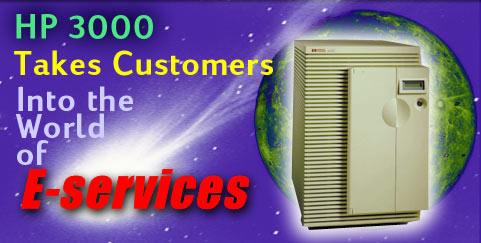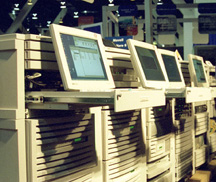 |
Click for HP Sponsor Page |
| November 2001
Virtual array intro heralds 3000 SAN era The 7100s store up to a terabyte of data on disks of up to 72Gb, and give customers a way to share storage among HP e3000s and systems running Unix, Linux and Windows NT/2000 environments. HP says that SANs can increase the value of data availability in IT environments, making data more readily and quickly available, as well as enabling data sharing between users, servers and applications.
The A5814A-003 router, built by Vicom Systems for HP, has “enough smarts in it to handle the VA7100,” said Walt McCullough, the High Availability Solution Manager for the e3000 (CSY) division at HP. The arrays are destined to replace the HP SureStore AutoRAID 12H devices already certified for HP 3000s. Cost per megabyte and performance under redundancy operations will help CSY migrate its customers which need array storage to the new arrays, McCullough said. “We want to migrate off the 12H AutoRAID and move toward this type of technology,” he said. “This gets us on the low-end of that [12H capacity] range, and gives us much more on the top end.” Customers can configure the VA7100 with as little as five 18Gb disks, or pump up the array to take on as many as 15 72Gb disks for a top-end capacity of 1.08 terabytes. But McCullough said there’s more 7100 advantage over the 12H arrays than greater capacity. “You can create a topology where you have multiple 3000s hooked up to the VA, using hubs and switches,” he said. “It’s a way of slipping Storage Area Networking technology in, and getting the customers to manage it in the enterprise.” “The beauty of it over the AutoRAID is that you can configure more than eight LUNs on the device. It has a capacity of up to 64 LUNs.” This Logical Unit Number is a unique number that identifies a specific logical unit, which may be an end user, a file, or an application program. Controlling the VA7100 will require a Windows NT system at first release of the product for the HP 3000, McCullough said. That’s because the CommandView SDM application hasn’t been ported yet to MPE/iX. The NT system must run Service Pack 6A, and will need another FibreChannel router, D8602B, hooked to the secondary port of the VA7100. “Since there’s only two ports on the back of the VA7100, you would go through a hub or switch,” McCullough explained, “with four or five connections on the switch and one connection going into the VA.” Sharing this network accessed storage across several operating systems is another capability of the VA7100. McCullough cautioned that on “some of the operating systems you’ll want to use a secure LUN manager, to keep some of those operating systems from playing with the volumes. Particularly, NT has a talent for writing its signature on anything it wants to see, and that stamp usually wipes out other operating systems. “Everyone on the 7100’s port can see all the LUNs, and unless you have a way of securing the LUNs, every operating system is going to have problems with NT. So you’d want to wrap a secure LUN manager around the NT environment, if you’ll be playing with a single port where multiple operating systems are going to carving up the VA. You don’t want NT to get out. MPE plays nice.” The data will get to and from the servers much faster, too. AutoRAID devices use a 40Mb backplane, while the VA7100s use an 800Mb backplane. “This is going to help a great deal,” McCullough said. “There’s also a few things that caused the AutoRAID not to perform to its theoretical limit,” such as trigger software, that optimizes clusters, which was set too high on the devices, “so it never really kicked in.” In a later release, the VA7400 will be available for HP e3000 sites with its 2-gigabit/second interface, twice the speed of the VA7100s. Compared to the 12H SCSI connectivity of 20Mb/second, even the 7100 looks much faster. But such blazing FibreChannel interface speeds get watered down on the way to servers. “You’re not going to get any of that kind of performance,” McCullough said. “It’s just the connectivity rate. It’s a big fat driveway leading to the highway, so you can hook up a number of servers onto this fat driveway, to get data to your storage arrays in a quick manner.” Once a data is inside the storage array, it’s limited to the physics of the storage mechanism, such as disk drive transfer rates, and array trick tradeoffs such as caching and array protection.” “We’ve had difficulties letting customers understand these tradeoffs,” McCullough said. “The tradeoffs are getting better compared to the 12H algorithms. RAID 5 algorithms were a lot slower there.” Footprints carry a lot more capacity with the new arrays, too. One AutoRAID 12H system could max out at 12 disks; the same space can carry four VA7100s, each with 15 disks. Effective transfer rates for the VA7100 to the HP 3000, even using the SCSI-to-FibreChannel router, keep the servers busy. “You would be surprised at when the 3000 is turned up — we can make things hot,” McCullough said. “We’ve seen an effective throughput of 13 megabytes per second going through that. We can make a VA work really hard. It’s a big difference in performance between the AutoRAID and the VA.” Much of the difference comes from backplane speed increases; the VA7100’s is 800 Mb/second, 20 times as fast as the 12H backplane. The speed and extra capacity come at a cost between that of the 12H and the XP arrays. A minimal configuration of the VA7100, with five 18Gb disk drives and 256Mb of cache, is list priced $44,500. Top cost for the new array, fully loaded with dual controllers of 1Gb each and 15 36Gb disks, is $90,750.
|
Copyright The 3000 NewsWire. All rights reserved.

 HP first shipped the VA7100 systems earlier this
year, but a new fabric-enabled fiber router now makes them compatible
with e3000s. The newly-released Express 1 version of MPE/iX 7.0
already has the software required to use the arrays. The devices can
be used to boot the HP e3000, and customers configure LDEV1 as a 4Gb
volume, wasting no disk space.
HP first shipped the VA7100 systems earlier this
year, but a new fabric-enabled fiber router now makes them compatible
with e3000s. The newly-released Express 1 version of MPE/iX 7.0
already has the software required to use the arrays. The devices can
be used to boot the HP e3000, and customers configure LDEV1 as a 4Gb
volume, wasting no disk space.